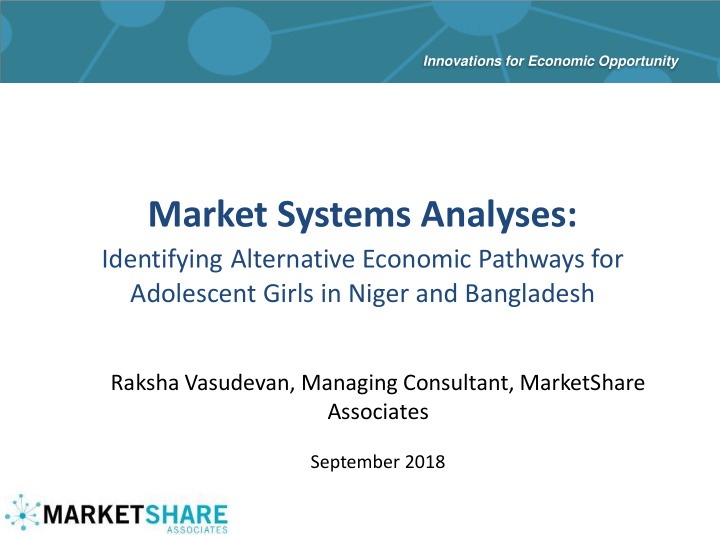



Innovations for Economic Opportunity Market Systems Analyses: Identifying Alternative Economic Pathways for Adolescent Girls in Niger and Bangladesh Raksha Vasudevan, Managing Consultant, MarketShare Associates September 2018
Innovations for Economic Opportunity Designing the methodology ‘Standard’ methodology for conducting market analyses… 2
Innovations for Economic Opportunity Designing the methodology • And guidance on conducting gendered analysis 3
Innovations for Economic Opportunity Designing the methodology ?? How to put the 2 together? How to take norms of early marriage & childbirth into account? How to understand the desired pathways of adolescent girls? 4
Research process STEP RESULT 1.Literature • Long list of sub-sectors review, expert interviews Participatory sub- • Short list of prioritized sector selection sub-sectors •‘Deep dive’ into selected Fieldwork sub-sectors) 5
Research process Special attention was given to: 1. Composition of research teams (i.e. mostly women) and the times and places of interviews 2. In-depth analysis of the daily lives of girls 3. Roles of (older) women within selected sub-sectors 4. High-leverage entry points 6
Sector-specific findings NIGER COWPEAS LIVESTOCK TAILORING Ranking for Medium High Low intervention DAIRY COTTON CRAFTS TVET Ranking for Medium High Medium intervention 7
Overarching Recommendations 1. Consider using expansion and upgrading models for women and adolescent girls within specific sub-sectors. a) Expansion: support more women (and girls) to move into roles that women already play. b) Upgrading : support women in moving into higher-value activities 2. Promote female business leaders and other role models for girls. 3. Develop clear partnership selection criteria. 4. Facilitate the development of financial products, platforms and money management programs tailored for adolescent girls with existing savings and credit platforms. 5. Always consider ‘light - touch’ approaches first . 8
Reflections for research with similar populations 1) Consider girls’ existing unpaid care duties in intervention design. 2) ‘Do no harm’ principle and the role of education. 3) Consider differences between girls’ circumstances in designing activities. 9
Recommend
More recommend